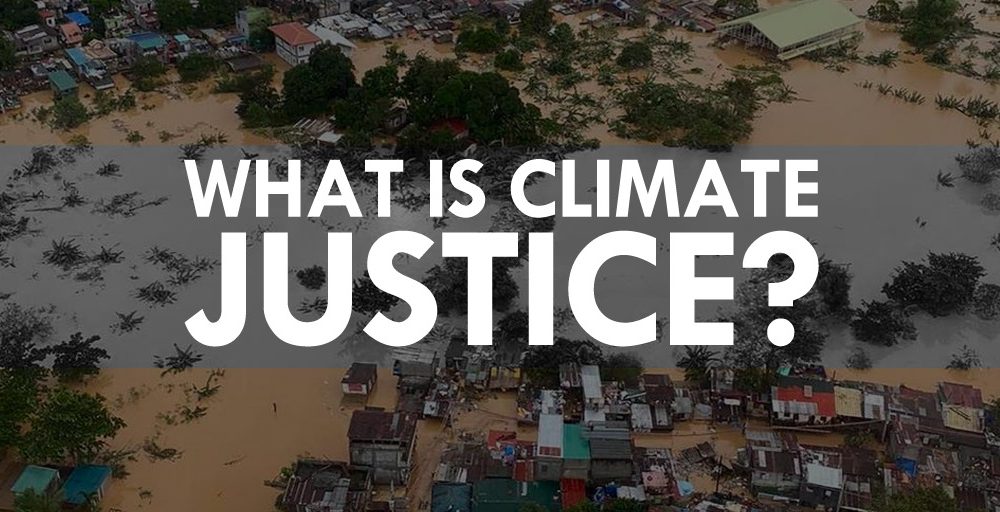Home > Blog > Climate Change
What is Climate Justice?

On December 9, 2019, the Philippines made history at the United Nations Climate Change Conference in Madrid where the country’s Commission on Human Rights (CHR) declared that fossil fuel corporations such as Shell, ExxonMobil, Chevron, BP, Repsol, Sasol, and Total “could be found legally and morally liable for human rights harms to Filipinos resulting from climate change.”
This announcement was four years in the making, stemming from a complaint filed by typhoon survivors and non-governmental organizations on humans right violations of major carbon-emitting companies. This gave birth to public inquiry hearings in Manila, New York and London, producing comprehensive evidence on climate-induced disasters in the country. Greenpeace Southeast Asia Executive Director Yeb Saño called CHR’s announcement in Madrid “a historic moment for people and the planet, and a landmark victory for climate justice.”
 Advocates call for climate justice during the protest in Manila last November 2019
Advocates call for climate justice during the protest in Manila last November 2019
The Need for Climate Justice
Climate change, which has prompted countries to declare a climate emergency, has led to the rapid rise in global temperature mainly caused by human activities such as burning fuel. Because of global warming, the United Nations Office for Disaster Risk Reduction reported that in the past two decades, major disasters surged by a staggering 45%, claiming more than a million lives and amounting to losses of almost US$3 trillion.
When the world’s wealthiest businesses create wanton and massive environmental pollution, the world’s poorest suffers. This includes the Philippines, which according to Vision of Humanity, is one of the countries most affected by natural disasters in the last three decades. In 2019 alone, the Philippines ranked 2nd in having the most number of displaced people (over 4 million) due to disasters. Just this month, Auring, the country’s first tropical cyclone for 2021, forced 50,000 residents in Mindanao to relocate in evacuation centers.
Recently, the World Meteorological Organization (WMO) announced that despite last year’s La Niña and the ongoing pandemic, which shut down businesses and limited carbon-producing transportation, 2019 still emerged as the second hottest year on record. Last year also ended as the hottest decade on record, proving that global commitments to reduce greenhouse gasses are not enough. WMO reported that “Sustained heat and wildfires in Siberia and low Arctic sea ice extent, as well as the record-breaking Atlantic hurricane season were among the standout features of 2020.”
 Aftermath of Typhoon Ulysses last November 2020
Aftermath of Typhoon Ulysses last November 2020
Breaking Down Climate Justice
The first Climate Justice Summit was held in the Netherlands in 2000. One of its objectives was to reinforce climate change as a rights issue beyond being an environmental one. Climate litigation, which is part of environmental law, uses the law to impel governments and businesses to address climate change. Legal claims may involve any of the following:
- Exposing breaches of the state’s constitutional rights
- Challenging administrative decisions that cause environmental harm, such as permitting projects on road transport, coal power plants and cement production
- Making organizations accountable for negligent acts against the environment
- Protecting consumers from misinformation on the climate impacts of promoted products and services
- Emphasizing the role of climate change mitigation in protecting human rights
The need for climate justice is pressing as low-income communities and countries struggle with dealing with climate change effects. Rebuilding after natural disaster impacts takes longer, exposing more individuals to climate hazards. According to this study, as of 2015, the most industrialized countries such as the U.S. and those in the European Union produced 90% of global excess gas emissions. As United Nations Secretary-General Antonio Guterres said in an interview, “Climate change is happening now and to all of us. No country or community is immune. And, as is always the case, the poor and vulnerable are the first to suffer and the worst hit.”
 Supporters in the Netherlands demonstrate against the construction of a coal plant in the Eemshaven. (June 2016)
Supporters in the Netherlands demonstrate against the construction of a coal plant in the Eemshaven. (June 2016)
Achieving Climate Justice
In 2013, Urgenda, a non-profit foundation in The Netherlands filed a case against the Dutch government for failing to decrease its carbon dioxide emissions according to minimum standards set by scientists. Urgenda argued that the government’s inaction fueled climate change, putting citizens at risk and endanger their human rights. In 2015, the Supreme Court ruled that the government should reduce its country’s emissions goal by 25%. This was reinforced by a 2019 ruling, which bound the state of Netherlands to take concrete steps to address climate change. Because of this success, more organizations were inspired to file climate justice cases, resulting in more than a thousand cases in 33 countries.
As Greenpeace Philippines awaits the results of the climate justice case filed by the CHR, it remains vocal about how climate disaster risk reduction (DRR) should be part of the government’s pandemic recovery plan. Greenpeace believes that climate justice involves investing more in the citizens’s well-being across the sectors of health, energy, transport, water, food, waste and education.
With Typhoons Ulysses and Rolly battering the country last year, affecting almost 5 million people, Greenpeace Communications Campaigner Angeli Cantillana wrote, “It is not just global warming we are dealing with, but climate change in the hands of big companies, including those entities that primarily contribute to greenhouse gas emissions. These are the companies that choose to ignore decades of appeal from the climate justice movement. That alone is social injustice.”

